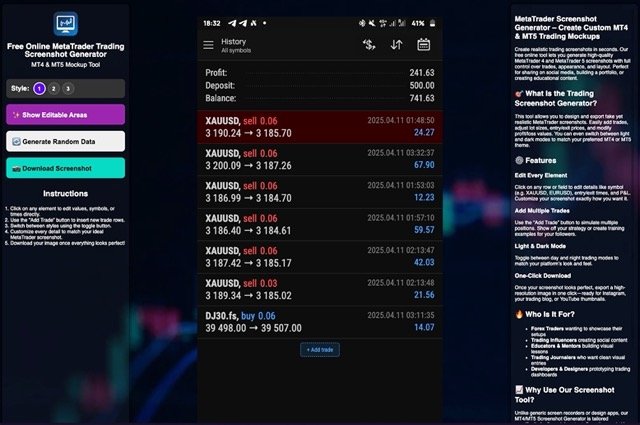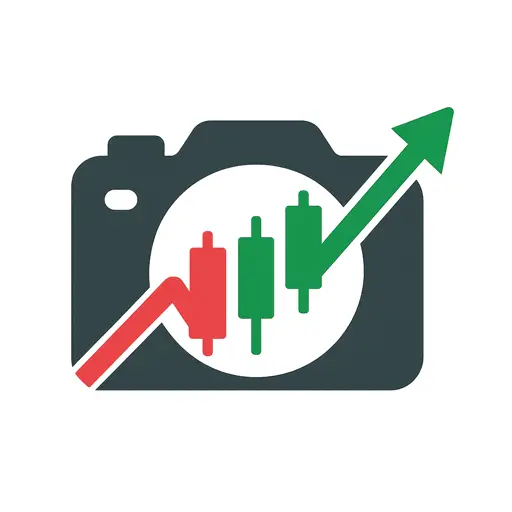Why Visual Evidence Matters in Explaining Risk Management
When teaching trading or showcasing trading strategies, few things build credibility as effectively as clear, compelling visuals. Have you ever tried to explain a complex risk management setup purely with words? Chances are your audience quickly lost interest or misunderstood key points. This is where screenshots from trading platforms such as MetaTrader become invaluable.
Imagine this: you’re an educator trying to convey *why* you placed a stop loss at a particular price level or how you scaled out of a position to limit risk. Simply saying “I set a 2% risk per trade” doesn’t quite cut it. Your students or followers need to *see* it in action — the entry point, take profit levels, the stop loss, and even the trade history that confirms your strategy’s success or lessons learned.
Utilizing screenshots in blog posts, social media updates, or paid signal subscriptions can transform dry explanations into engaging, trustworthy content. This not only demonstrates your transparency but also builds confidence in your audience, crucial for personal branding in the competitive trading education space.
Key Risk Management Concepts to Showcase with Screenshots
Before diving into how to capture the perfect screenshot, let’s identify the *vital elements* of risk management that resonate well visually:
1. Position Sizing
How large is the position relative to your account size? It’s critical to demonstrate how you calculate and adhere to your position sizing rules to maintain consistent risk exposure.
2. Stop Loss Placement
The location of your stop loss speaks volumes about your discipline and market understanding. Showing a clearly drawn stop loss, along with the rationale behind its placement, can enlighten your audience on risk-reward ratios.
3. Risk-Reward Ratios
Visualizing your trade setups with entry, stop loss, and target levels allows followers to intuitively grasp expected returns vs. potential losses.
4. Trade Outcomes and Learning Points
Showcasing both winning and losing trades complete with annotations promotes authenticity, emphasizing that risk management is as much about preserving capital as chasing profits.
5. Adaptability and Strategy Tweaks
Sometimes, risk management isn’t static. Demonstrating adjustments based on market conditions or trade progression adds sophistication and real-world practicality to your lessons.
How to Create Impactful Screenshots that Enhance Risk Management Lessons
Now, how exactly can you turn a raw trading platform screenshot into a professional, educational asset? Following are some practical tips:
- Use Clean, Focused Visuals: Crop unnecessary panels or clutter to spotlight the trade setup and risk parameters only.
- Annotate Strategically: Highlight key points with arrows, text boxes, or color-coded markers explaining entry, stop loss, and take profit.
- Maintain Consistency: Stick to a uniform style across screenshots for brand cohesion and easier comprehension.
- Include Relevant Metrics: Display risk percentages, pip distances, or reward ratios prominently.
- Show the MetaTrader Terminal Window: Including trade history or chart properties adds credibility to your claims.
- Leverage Tools Designed for Traders: Generic screenshot tools don’t always display your trade details in the best light. This is where a specialized tool like Trading Screenshot Generator shines — it offers quick, professional screenshots optimized for trading educators.
Case Study: Turning a Simple Screenshot Into a Trust-Building Tool
Let me share a quick story. Laura, a trading coach, once struggled to convince her followers about the importance of strict stop loss discipline. Her explanations were well-written but didn’t translate into increased client signups or engagement.
By adopting dedicated screenshots showcasing actual trades with clearly marked stop losses and profit targets, her content transformed overnight. One image of a recent setup with annotated risk-reward levels and clear “Before” and “After” outcomes received triple the usual comments and motivated her followers to apply the same principles.
She used those screenshots not only on her blog but also in email newsletters and social media posts — all generated effortlessly through a tool customized for MetaTrader visuals. This consistency and clarity grew her brand reputation significantly.
The SEO Power of Well-Optimized Trading Screenshots
You might wonder, “SEO and screenshots? How do those relate?” There’s more to images than mere aesthetics when it comes to search engine optimization:
– **Alt Text:** Properly written alt attributes with relevant keywords help search engines understand the image content. E.g., “Trading screenshot highlighting risk management stop loss placement on MetaTrader.”
– **Load Speed:** Optimized images from specialized tools maintain fast load times, ensuring better user experience and ranking.
– **Structured Content:** Integrating screenshots within long-form, keyword-rich articles increases reader retention and encourages social shares — both positive SEO signals.
– **Engagement:** Enhanced content invites comments and backlinks, reinforcing authority in the financial trading niche.
Keeping your content natural and appealing with diverse multimedia drastically increases your chances of ranking on relevant queries such as “risk management trading examples” or “how to set stop losses MetaTrader.”
Best Practices for Using Screenshots Ethically and Effectively
While screenshots are powerful, they come with a set of responsibilities:
– Transparency: Never manipulate trade results or hide losses. Always present an honest picture.
– Privacy: Blur out any personal data if your screenshots include sensitive information.
– Clarity: Make sure annotations are easily legible and don’t overwhelm the main message.
– Context: Always accompany screenshots with detailed explanations to ensure your audience correctly interprets them.
– Compliance: Follow platform rules regarding sharing trade data and adhere to regulatory guidelines when promoting financial education.
Remember, your aim is to enhance trust, not just impress with fancy visuals.
Practical Steps to Start Using Trading Screenshots Now
Ready to take your risk management demonstrations to the next level? Here’s a simple workflow to get started:
1. Identify a Key Trade Setup: Find a recent example that clearly illustrates your risk management approach.
2. Open MetaTrader: Adjust your chart view to emphasize entry, stop loss, and take profit.
3. Use the Trading Screenshot Generator tool: Capture high-resolution, annotated screenshots tailored for educational purpose.
4. Insert into Your Content: Whether a blog post, email newsletter, or social media update, place the visual near your explanation for maximum effect.
5. Engage Your Audience: Invite questions or feedback to foster a learning community around your risk management coaching.
6. Review and Iterate: Over time, analyze which types of screenshots resonate most and refine your strategy.
Bonus Tip:
Combining screenshots with video walkthroughs or live webinars turbocharges trust and comprehension — but strong images complement these perfectly for anytime reference.
Conclusion: Harness the Power of Screenshots to Elevate Your Trading Education
In a world saturated with financial content, standing out requires more than just knowledge — it demands clear, authentic, and engaging communication. Screenshots showcasing your risk management strategies provide undeniable proof of your expertise and trading ethics.
Leveraging specialized tools to create beautiful, customized MetaTrader screenshots lets you share your journey, educate your followers, and build lasting trust. So why stick to words alone when a well-crafted visual can speak volumes?
Take the next step today and explore how Trading Screenshot Generator can become your secret weapon in demonstrating risk management like a pro.
—
“The journey to mastering risk management is often complex—but with the right visuals, we make learning not just easier, but inspiring.” — A Trading Educator’s Reflection






